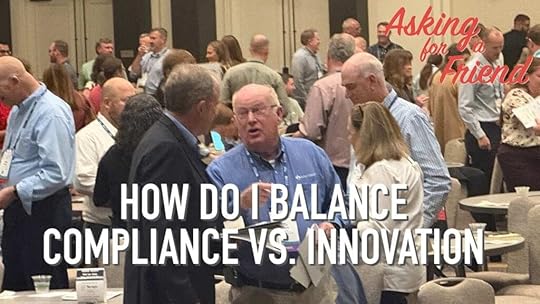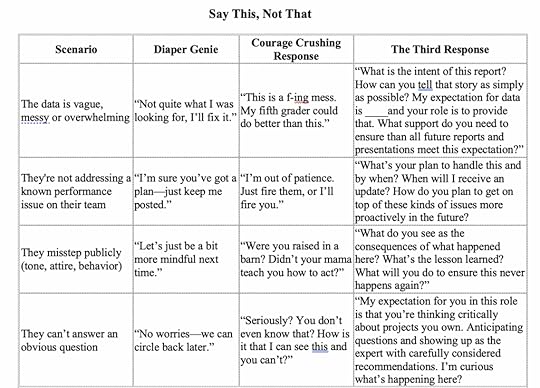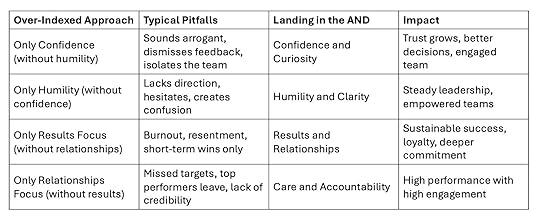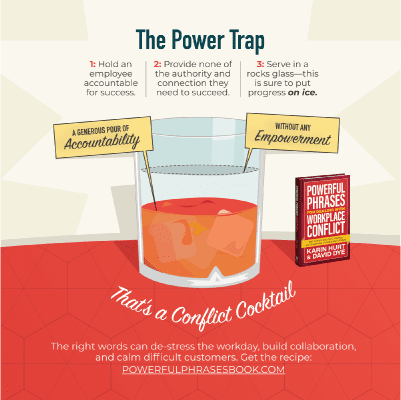David Dye's Blog, page 2
September 18, 2025
How to Inspire Innovative Thinking in a Risk-Averse World
You love the idea of a Courageous Culture—one where people speak up, challenge the status quo, and offer game-changing ideas.
But what happens when you’re working in a high-stakes environment where there’s zero room for error?
Where the mantra is, “We don’t try things—we get it right.”
So how do you encourage innovative thinking when failure isn’t an option?
“We Can’t Afford Mistakes” vs. “We Can’t Afford Silence”“This isn’t a tech startup. If we screw up, someone gets hurt. Or worse.”
Totally valid.
Industries like healthcare, aviation, finance, engineering, and energy have tight margins for error—and for good reason. You want your surgical team to follow the checklist. You need your air traffic controller to follow the script. 
But here’s what’s also true:
When people don’t feel safe to raise a concern, challenge an assumption, or offer a smarter way—you’re operating with a blindfold on.
And that’s a risk you can’t afford either.
Clarity Isn’t the Enemy of Innovation—It’s the CatalystThe secret to courageous cultures in compliance-driven industries?
Clarity and boundaries.
Innovation thrives when people know:
Exactly where ideas are welcome
What rules are non-negotiable
The structured process for bringing ideas forward
Without clarity, people default to silence. Or worse, guesswork.
Start by saying:
“Here are the areas we must follow to the letter. But over here—we’re open to better ways.”
That simple shift reframes innovation as responsible contribution, not reckless experimentation.
Risk-Averse Teams Still Need Room to Think (Video)At a recent keynote for the FCCS Risk 360 Conference, I was asked:
“How do I empower people to innovate in one part of the business while enforcing strict compliance in another?”

More in this week’s Asking for a Friend Video
My answer: Structure the freedom.
Give people space to think, speak up, and solve problems—with defined parameters.
That might look like:
Guardrails around what can’t change
Clear invitations to innovate in specific areas
A simple, safe channel to vet and test ideas
Accountability loops to ensure nothing slips through the cracks
This isn’t about being less disciplined. It’s about being more deliberately curious.
Why High-Stakes Environments Need More Courage—Not LessCourageous Cultures aren’t about being loud, bold, or reckless.
They’re about being responsible enough to care out loud—especially when it’s uncomfortable.
And in high-risk industries, that courage matters more than ever.
Think about it:
Who’s going to notice the early signs of a process breakdown?
Who’s closest to the inefficiencies draining time and resources?
Who can spot a small defect before it becomes a catastrophic failure?
Your people.
But only if they feel safe enough to speak up.
Want to start today?
Gather your team and ask:
“Where are we crystal clear about expectations?”
“Where do people hesitate to speak up?”
“What’s one area we could improve—if we gave people the freedom to try?”
You don’t need a massive culture overhaul.
Just a few clear signals that say:
“It’s safe to think. It’s safe to speak up. And we’ve got your back.”
Are you looking for more ways to build a more Courageous Culture in your organization? Learn more about our approach to highly interactive keynotes or our strategic innovation programs.
The post How to Inspire Innovative Thinking in a Risk-Averse World appeared first on Let's Grow Leaders.
September 15, 2025
What to Do When Your Clueless Boss (or Team) Overlooks the Obvious
You’ve been there. That moment when the conversation derails, the logic seems obvious to you, but your seemingly clueless boss or team just stares back—or worse, keeps plowing forward. You’re left muttering under your breath, “Don’t they get it?”
Here’s the thing: nine times out of ten, the answer is no. They don’t get it.
And that gap, the communication breakdown, isn’t a dead end. It’s an invitation to lead.
Turning “They Don’t Get It” Into OpportunityYou might assume the worst: They know, and they just don’t care. Sometimes that’s true, but far more often they really don’t have the full picture.
Maybe they don’t see the consequences. Maybe they’re working from a different assumptions or values. They’re in their own swirl of stress and frustration, and don’t realize what you could bring to the conversation.
The opportunity here is twofold:
First, to better understand their perspective (you might discover a strategic insight you hadn’t considered).
And second, to help them understand yours (because your insights are the missing puzzle pieces that could complete their view).
The choice is yours: spiral into frustration—or step into leadership.
What to Do When Your Clueless Boss Can’t See What’s Obvious to YouImagine this: a senior leader shifts a process without input from your team. It feels like they just dropped a boulder into your already overflowing bucket.
The easy (but harder in the long run) path? Stay quiet, soldier on, and let your resentment grow until you explode or walk away.
The better path? Start the conversation.
Here are some specific phrases you can use:
“As we incorporate this change, here are the tradeoffs I see. We could adjust our KPIs for the next few weeks, add more resources, or work extra hours. Which option makes the most sense to you?”
“I care about making this work and want to be sure we’re sustainable. Can we talk through what success would look like without burning people out?”
Or here’s one that one of our clients, let’s call her “Jane,” recently used with her Chief Operating Officer: “You made this massive process change without including me, and now it’s going to take weeks longer to implement. If you’ll bring me in on the decision itself, I can help us get there faster.”
That conversation went well, and the next time the C.O.O. had a major change in mind, she invited Jane to the discussion.
Silence solves nothing. Your job isn’t to complain—it’s to give leaders the data they don’t have and frame choices clearly. That’s real influence.
What to Do When Your Team Doesn’t Get ItFlip the scenario. Maybe it’s your team that doesn’t “get it.” They’re dragging their feet, rolling their eyes, or half-heartedly doing the work.
Often the missing piece is the “why.” Somewhere between your senior leader’s office and the front line, the “why” got lost and all that reached them was the “what.”
This is your opportunity to lead.
Clarify the purpose. “Here’s why this matters to our customers and our future success.”Check for understanding. “What are you hearing me say—and how does that land for you?”Diagnose credibility gaps. Ask “What have I missed? What’s the part where you feel like I ‘just don’t get it’?”Diagnose capability gaps. Sometimes, the why isn’t the issue. When everyone’s aligned and gets it, but performance isn’t there, they may need more training, encouragement, or accountability.When you reconnect people to meaning, momentum follows.
For Senior Leaders and Skip-LevelsWhen you’re leading multiple layers down, beware the dilution effect. Your managers may have understood part of the “why” but rushed to cascade the “what.” By the time it hits the front line, people are working without purpose.
Check for understanding with your skip-levels:
“What’s your understanding of this change?”“What does it mean for you at your level?”“What questions are you hearing from your team?”And when you find gaps, gently fill them in. Reinforce the importance of communicating not just tasks but also context and meaning.
Your Clueless Boss (or Team) are Your Call to LeadershipEvery time you ask, “Don’t they get it?” you stand at a crossroads.
You can stew in frustration, or you can step up and lead. That means clarifying the why, voicing tradeoffs, and creating space for actual conversation.
Leadership isn’t quiet compliance. It’s courageous communication: advocating for your team, your customers, and your shared success.
The post What to Do When Your Clueless Boss (or Team) Overlooks the Obvious appeared first on Let's Grow Leaders.
September 12, 2025
5 Leadership Communication Skills to Use When You’re Angry, Frustrated, or Overwhelmed
Episode 320: When frustration hits, how strong are your leadership communication skills—do they help you build trust, or do they risk tearing your culture down?
As a leader, those heated moments can make or break your team’s culture. What you say in frustration can either reinforce accountability and trust—or unravel morale and push your best people away. This episode gives you a way forward, so you can respond with clarity and confidence without losing your cool.
By listening, you’ll discover how to:
Ask yourself five quick questions that reset your emotions and keep you steady under pressure.
Use simple, direct language that addresses the issue without burying the truth or crushing morale.
Model healthy accountability so your team learns how to navigate tough situations the right way.
Hit play now to learn how to turn frustrating moments into culture-building opportunities that strengthen your leadership and your team.
Building Calm Under Pressure[00:58] Recognizing the flashpoints.
Moments of frustration at work can tempt you into over-softening or lashing out. Both can damage your culture—what matters most is choosing a grounded response.
[01:57] The two extremes of bad communication.
Learn how “Diaper Genie” avoidance and blow-up reactions erode trust, accountability, and performance.
[02:52] The third response.
Instead of dodging or detonating, you can choose a clear, direct, emotionally steady response that balances confidence, humility, and results.
[04:06] Five reset questions.
David introduces five quick questions leaders can ask themselves in heated moments to reset their mindset and practice effective leadership communication skills.
[05:31] Shifting perspective.
Exploring how your team might see the situation helps you avoid assumptions and reframe the conversation with empathy.
[07:53] Scenario: messy data.
Hear the stark contrast between avoidance, shaming, and the third-way approach that sets clear expectations without crushing morale.
[09:07] Scenario: ignoring performance issues.
Discover how to coach a team leader with direct questions that create accountability and move the issue forward.
[10:09] Scenario: public misstep.
Learn how to handle visible mistakes in a way that preserves dignity while reinforcing standards.
[11:11] Modeling accountability under pressure.
Strong leadership communication skills mean setting expectations, reinforcing culture, and staying steady even when emotions run high.
[12:01] The leader’s next step.
Pause, ask yourself the five reset questions, then deliver one clear message with a follow-up plan—this is how you change your culture one conversation at a time.
The post 5 Leadership Communication Skills to Use When You’re Angry, Frustrated, or Overwhelmed appeared first on Let's Grow Leaders.
September 5, 2025
One Leadership Mindset Shift to Stop Burnout, Avoid Overwhelm, and Improve Your Work Life Balance
Episode 319: Are you the leader everyone turns to for help—yet secretly running on empty? What feels like generosity today can quietly drain your energy and keep your team from growing tomorrow. It’s time for a mindset shift.
If you’ve ever felt torn between being the “go-to helper” and protecting your own energy, this episode is for you. Over-helping might feel like the right thing in the moment, but it can quietly drain your well-being and hold your team back from growing. By exploring the hidden traps of “Super Helper Syndrome,” you’ll learn how to set boundaries without losing your empathy—and discover how to lead with both heart and strategy.
In this conversation with psychologist and leadership coach Jess Baker, you’ll discover:
How to spot the hidden costs of compulsive helping and prevent exhaustion, resentment, and self-criticism.
Practical ways to set healthy boundaries that actually empower your team instead of disempowering them.
Mindset tools you can use to quiet the inner critic and lead with empathy while protecting your own well-being.
Hit play now and learn how to make one powerful shift that frees you from over-helping and helps your team thrive.
Mindset Shift Moments: Turning Over-Helping into Empowered Leadership00:00 — Are you helping… too much?
David frames the episode around a leadership mindset shift. Your urge to help might be quietly holding you—and your team—back. David introduces guest Jess Baker and the “Super Helper Syndrome.”
02:00 — Defining Super Helper Syndrome.
Jess explains the pattern of compulsive helping (to your own detriment), with telltale outcomes like exhaustion, resentment, and being taken for granted. Plus, why it isn’t a medical diagnosis but a cluster of behaviors.
05:23 — How over-helping disempowers teams.
David shares how jumping in with answers stunts development, resilience, and independence. Leaders feel helpful, but the team stops growing.
07:40 — Boundary-setting in the real world.
A practical script: time-box your availability (“You’ve got me for 45 minutes—how can I be most helpful?”) and clarify what you won’t be doing right now.
08:26 — Model the boundaries you want.
Jess urges leaders to role-model norms (e.g., no weekend emails) and to evolve from “invisible supporter” to a strategic, empathic leader who still keeps empathy intact.
12:14 — Your brain protects you, it doesn’t praise you.
A pivotal mindset shift: that harsh inner voice isn’t built to make you feel good; it’s built to keep you “safe.” Seeing this clearly opens the door to new responses.
17:15 — The decentering technique.
A simple CBT tool to tame “should” thoughts: prepend, “I’m having the thought that…” to create distance, reduce shame, and choose a better next action.
29:12 — The four irrational beliefs.
Jess outlines the hidden drivers: the Good Person belief, Help Everyone belief, “They couldn’t survive without me,” and the No Needs belief—how they fuel over-giving.
33:48 — Deconstructing harmful beliefs.
Step through acknowledgment, exposing the belief as irrational, naming its harm, and letting it go—a practical mindset shift playbook you can revisit.
37:37 — Healthier replacement beliefs.
Swap in empowering affirmations (e.g., “My self-worth isn’t dependent on helping others”) to cement the mindset shift and set “healthy helping” boundaries.
Jess is a Chartered Psychologist and an Associate Fellow of the British Psychological Society (CPsychol AFBSsS). She began her career in public healthcare and has been practising as a Business Psychologist and leadership coach for twenty years. Her award-winning book, The Super-Helper Syndrome, has been translated into Chinese, Japanese, Turkish and will shortly come out in Polish.
The post One Leadership Mindset Shift to Stop Burnout, Avoid Overwhelm, and Improve Your Work Life Balance appeared first on Let's Grow Leaders.
September 3, 2025
From Ticked Off to Tactical: What to Say Next When You’re Frustrated at Work
When you’re frustrated at work, it’s rarely about a single moment—it’s about patterns.
You’ve set clear expectations. You’ve checked for understanding. Your team should now know what good looks like.
But here you are—again.
The data’s a mess.
The prep is lazy.
They can’t answer an obvious question.
They miss the moment, dodge the issue, or show up completely off-tone.
You’re frustrated—and you should be.
What you say next will either reinforce your culture or unravel it.
In that flashpoint, two temptations show up fast:
You might reach for the Diaper Genie response—wrap the message in so much softness and spin that the real issue gets buried. Because after all, they SHOULD KNOW. Maybe if you just give them a nudge. It smells better in the moment, but the mess remains. Nothing changes.
You might blow—shame, blame, sarcasm, or intimidation. A sharp comment, an eye roll, a public takedown. These are the courage-crushing behaviors we break down in Chapter 4 of Courageous Cultures. They shut people down and drive your best talent away.
Or… you make the shift. You deliver a Third Response—clear, direct, emotionally steady. You name the issue and push the conversation forward—without disguising the truth or damaging the relationship.
What is the Third Response?It’s not a script. It’s a decision.
The Third Response is what you say when you’re frustrated but still want to respond in a human-centered, “land in the and” way.
It’s a grounded, specific, and action-oriented response.
These five questions take less than 30 seconds. But when you feel frustrated at work, these questions will reset your entire response:
What’s my intent here?Am I trying to create clear accountability? Raise the bar? Fix a recurring issue for good? What do I want to change because of this conversation?
What specifically needs to change?Is it effort? Follow-through? Awareness? Standards?
How might they see this?Are they overwhelmed? Stuck? Avoiding something? Genuinely unaware? Lacking a fundamental skill?
What’s the one message I need them to hear?Strip it down. No disclaimers. Just one clean point.
What do I expect them to do next—and by when?You don’t want to have this conversation again. But if there’s no commitment or follow-through, you’re just venting. Schedule the finish with a clear timeline where they will show you their follow-through.

The Third Response gets you out of the blur-or-blow trap.
You protect your standards and culture without putting the other person on the defensive.
You stay steady without softening the issue.
You reinforce what matters without crushing morale.
And most importantly, you model what healthy accountability looks like under pressure.

This is how courageous cultures get built—one response at a time.
When you’re frustrated at work, the worst thing you can do is speak in a way that makes things worse.
Don’t disguise the truth.
Don’t detonate.
Pause.
Get clear.
Say what needs to be said—set the tone for what happens next. Then, follow through and watch your culture change.
The post From Ticked Off to Tactical: What to Say Next When You’re Frustrated at Work appeared first on Let's Grow Leaders.
September 1, 2025
Land in the AND: How the Best Leaders Blend Confidence and Humility
Confidence or humility? Results or relationships? You don’t have to choose. How to be a human-centered leader and land in the AND.
One of the most common questions we hear from leaders is this:
“Should I focus more on results or on people?”
“Should I show more confidence or stay humble?”
And the answer is always: Yes.
Because the most effective leaders don’t choose between these values—they embrace the tension and land in the AND.
They…
Lead with confidence and humility.
Focus on results and relationships.
Are strong and kind. Driven and collaborative. Clear and curious.
This isn’t about doing everything perfectly or becoming a unicorn who always knows exactly what to say. It’s about holding space for what may feel like opposites—and knowing that the best leadership lives in that intersection.
We call this mindset Landing in the AND—and it’s one of the most powerful shifts a leader can make.

Confidence is magnetic. It helps others feel safe in your leadership. It allows you to speak with clarity, act with purpose, and inspire follow-through when things get tough. When you’re confident, people can feel your belief—not just in yourself, but in the team, in the mission, and in what’s possible.
But confidence alone isn’t the full story.
Pair it with humility, and now you’re leading with your whole self. You’re grounded, open to feedback, and fully aware that leadership is a shared experience—not a solo performance.
Humility helps you pause before reacting. It helps you say, “I don’t know the answer to that—but I’ll find out.” It makes it easier for others to speak up, challenge your thinking, and bring their best ideas forward.
Together, confidence and humility create a leadership presence that is both reassuring and relatable. One without the other can easily tip too far—into arrogance or self-doubt. The strength lies in the balance.
Landing in the AND means you can say:
Results AND Relationships: The Foundation for Sustainable Success“I believe in this direction, and I want to hear what I might be missing.”
“I’ve got experience here, and I’m always learning.”
If you’re only focused on metrics, deadlines, and deliverables, you might get short-term wins. But without care and connection, those wins often come at the cost of trust, morale, and long-term performance.
On the flip side, when leaders prioritize relationships but avoid accountability, teams can become unclear, unproductive, or unmotivated.
The truth is, your people and your results need each other. Great performance doesn’t come from pressure alone—it grows in environments where people feel supported, challenged, and seen.
Leaders who Land in the AND recognize that productivity and empathy are not in conflict. They work together.
They clarify expectations and ask how people are doing.
>They address performance gaps and coach with compassion.
>They celebrate wins and reflect on how the journey felt along the way.
This sounds like:
How to Start Leading from the AND“Let’s talk about what success looks like, and how we can get there together.”
“I care about your growth, and I’m committed to helping you succeed.”
Landing in the AND doesn’t require a total leadership overhaul. Small shifts make a big difference. Here are a few places to start:
1. Know your strengths—and keep buildingConfidence comes from clarity. Take time to reflect on your leadership superpowers. What do people count on you for? What do you do well that’s uniquely yours? Then ask yourself: how am I using those strengths to lift others up?
2. Invite challengeHumility means welcoming other perspectives. Ask your team, “What am I missing?” or “What would make this better?” When you model openness, you give permission for the best ideas to surface—even if they challenge your own.
3. Prioritize people and performanceWhen you’re prepping for a meeting or project, ask two quick questions:
“What result are we driving toward?”
“How are people experiencing the work right now?”
Both matter. Both influence outcomes. You’re leading the whole system, not just the spreadsheet.
Your words reinforce your mindset. Practice saying things like:
“We’re moving fast and making time to connect.”
“This is a high priority and I want to hear your input.”
“We’re celebrating what’s working and looking at where we can grow.”
What Happens When You Lead from the ANDWhen you consistently lead from the AND, your team starts to mirror it.
They become more confident and more collaborative.
>They focus on high standards and care for one another.
>They feel safe to take risks and own results.
And you? You start to experience more energy, less rework, deeper trust, and more sustained success—because you’re no longer carrying the tension of either/or. You’re modeling what it looks like to thrive in complexity. To lead with clarity and heart. To show up with your full self, and make space for others to do the same.
The best leaders land in the AND.
That’s where resilience grows, trust deepens, and real influence begins.
Your turn. What is your best human-centered leadership best practice to land in the AND?
See Also: Get Your Team Back on Track Fast (Asking For a Friend)
Can We Teach Leaders Humility? (Spoiler: You can and here’s how)
The post Land in the AND: How the Best Leaders Blend Confidence and Humility appeared first on Let's Grow Leaders.
August 29, 2025
One Incredible Leadership Communication Skill That Will Transform Your Relationships
Episode 318: What if one leadership communication skill could instantly energize your relationships and boost your impact?
In this episode, you’ll discover a communication tool that goes far beyond a quick “thank you.” It’s about tapping into genuine gratitude in a way that not only uplifts others but also transforms how you show up as a leader. If you’ve ever wanted your team to feel more valued and engaged—or you’ve been searching for a way to feel more grounded and joyful yourself—this conversation is exactly what you need.
Here’s what you’ll walk away with when you listen:
How writing letters of gratitude benefits not just the recipient, but you as the writer. Seven proven ways gratitude strengthens leadership, builds loyalty, and elevates morale. Practical, easy-to-use frameworks to express meaningful appreciation—even if writing isn’t your thing.Press play now to learn how gratitude can become your secret leadership advantage—and start practicing a skill that will transform both your career and your life.
Foundations of Gratitude in Leadership[00:00] – One Transformational Practice
David Dye introduces the episode with the promise of one practice that will transform your relationships, energize people around you, and improve your quality of life.
[02:59] – The First Letter of Gratitude
Joel Zuckerman shares how writing a single letter of gratitude unexpectedly became the catalyst for writing hundreds more and eventually a book.
[05:31] – Gratitude as a Leadership Communication Skill
The hosts discuss how gratitude shifts mindset, calms demeanor, and reframes work as a gift—making it a powerful leadership communication skill.
[06:27] – Why Gratitude Matters for Millennials and Gen Z
Joel explains Deloitte’s research showing that younger workers value being seen, valued, and recognized more than salary or vacation time.
[08:35] – The Seven Pillars of Expressive Gratitude
From personal joy to the ripple and legacy effects, Joel outlines the seven benefits of writing meaningful letters of gratitude.
[12:24] – What a Letter of Gratitude Is (and Isn’t)
Joel clarifies the difference between a heartfelt letter of gratitude and a standard thank-you note or quick emoji response.
[17:28] – Seven Paragraphs, Seven Sentences, Seven Words
A simple framework to help leaders use gratitude consistently, even if they don’t consider themselves writers.
[18:55] – Micro-Messages of Gratitude
Joel shares short, powerful phrases—like “This department would not run without you”—that instantly strengthen leadership communication skills.
[20:28] – Balancing Vulnerability and Recognition
The conversation covers leaders’ concerns about being “too complimentary” and how to calibrate gratitude while maintaining accountability.
[28:59] – Gratitude and Career Growth
Joel cites Harvard Business School research showing how gratitude makes employees more likable—and more likely to be promoted.
Joel Zuckerman has written for decades about golf, travel, and sports for all sorts of different publications, and this year, he released a book that we are very excited to share with you in this episode. The book is called Gratitude Tiger, and it’s all about a specific practice that’s going to create more joy for you and for others.
The post One Incredible Leadership Communication Skill That Will Transform Your Relationships appeared first on Let's Grow Leaders.
August 25, 2025
When You Make a Mistake at Work, Do This Next (With Video)
You know that sinking feeling when you make a mistake at work, The “uh-oh, did I just…” moment.
Maybe you hit Reply All when you shouldn’t have. Or you gave the client last year’s numbers. Or—you discovered that the 200 mugs you ordered proudly proclaim your department as Pubic Relations.
Yep. We’ve all been there.
The question isn’t whether you’ll mess up. The question is: How are you going to recover?
The fastest way to make a bad situation worse is to pull out the ol’ Diaper Genie Strategy—you seal it up tight, twist, twist, twist, and hope nobody notices the smell. That works for actual diapers. It’s a disaster for workplace mistakes. Because if you can’t smell it, you can’t fix it.
So instead of covering up or blindsiding your boss, use this simple, sanity-saving framework: The D.A.R.N. Method.
The D.A.R.N. Method for Recovering from a Workplace Mistake (Watch Video for More)

D – Disclose
No jump-scares. Tell them before they hear it from their boss, a client, or worse… social media. Keep it simple: what happened, and the root cause. This builds trust.
A – Accountability
Own your part. Even if it wasn’t all you. You might say, “I should have been closer to this situation” or “I know how important this is, and I want to do everything I can to make it right.” No blaming. No excuses.
R – Response
Share what you’ve already done to address it. “I called the customer to apologize, updated the numbers, and let the social media team know in case this goes public.” You’re showing that you’re not just dropping a problem—you’re leading the solution.
N – Next Steps
Come in with a plan: “Here’s what I think we should do next…” This is your moment to prove you can turn a mess into momentum.
No one expects you to be perfect, but they do expect you to be honest, proactive, and committed to fixing things. This method checks all three boxes and keeps you from spiraling into panic.
Q: What if I freeze and can’t find the words?
Lead with disclosure. Even, “I need to bring you up to speed on something that just happened” buys you a moment to breathe.
Q: What if my boss gets mad?
Let them. Then listen. Try, “I know you’re frustrated. I am too and I’m sorry. That’s why I’m so focused on making this better and preventing it from happening again.”
See Also: Powerful Phrases to Deal with a Moody Boss (Even a Dropper of F-Bombs
Q: Can’t I just email them?
If there’s any chance the issue will make them look bad, talk in person (or on video) first. Follow up with an email summarizing facts and next steps so there’s a record.
Q: What if it wasn’t my fault?
Focus on fixing first, context later. Stepping up—even when it’s not “yours”—shows leadership.
Q: What are some “accountability phrases” that don’t make me a scapegoat?
You can own your part without turning yourself into the office punching bag. The key is to acknowledge your role while keeping the focus on solving the problem, not assigning lifelong blame. Try these:
“Looking back, I can see where I could have caught this earlier.”
“Here’s what I’m doing to make sure this doesn’t happen again.”
“I was responsible for X, and here’s how I’m addressing it.”
“I see the impact this has had, and I want to help fix it.”
“I own my part of this, and I’m committed to getting us back on track.”
Notice what’s missing?
Phrases like “This is all my fault” or “I completely messed everything up”—because that invites people to pile on and doesn’t actually move the solution forward.
Q: What are some “next step” phrases that make me sound proactive instead of defensive?
You want to sound like you’re already steering the ship back on course, not floating helplessly in the water. Here are some ways to frame it:
“My immediate next step is…”
“I’d like to run this plan by you before moving forward.”
“Here’s how we can prevent this in the future…”
“I’ve identified two possible fixes—here’s the pros and cons of each.”
“Let’s agree on the next milestone so we can check progress.”
 These phrases keep the focus forward, invite collaboration, and signal that you’re not waiting to be rescued.
These phrases keep the focus forward, invite collaboration, and signal that you’re not waiting to be rescued.
Mistakes happen. Your career isn’t defined by the ones you make—it’s defined by how you handle them. So ditch the diaper genie, D.A.R.N. it, and turn your worst “uh-oh” moments into trust-building wins.
Learn more about our book Powerfurl Phrases For Dealing wih Workplace Conflict in this short video.
The post When You Make a Mistake at Work, Do This Next (With Video) appeared first on Let's Grow Leaders.
August 22, 2025
The Secret Delegation Skill to Improve Productivity, Teamwork, and Time Management
Episode 317: Do you try to delegate, only to have the team run off in fourteen different directions and waste time? You can improve your team’s productivity and time management with one communication skill.
Empowering your team shouldn’t mean more interruptions, rework, or missed deadlines. If you’ve tried handing off responsibility only to end up with more stress, this episode gives you a practical way to fix that without becoming a micromanager. Here’s what you’ll walk away with:
A proven method to delegate effectively while improving everyone’s focus and time managementA clear way to define what decisions your team can make—and which ones still need your inputTools to boost creativity and accountability without sacrificing controlPress play now to learn how to delegate with clarity and finally take time management off your list of leadership headaches.
Why Empowerment Without Clarity Backfires[00:00]
The episode kicks off with a powerful leadership question: “How do I empower my team without creating chaos?” Host David Dye introduces the secret to solving one of the biggest delegation challenges—so you can lead more effectively without hurting your team’s productivity or time management.
[00:51]
David shares common client frustrations—like team members constantly asking for input or, worse, taking rogue action without alignment. This leads to wasted time, poor decision-making, and stress on all sides.
[01:43]
Real-world stories highlight what happens when leaders empower without structure—like teams going off-brand or wasting time on low-priority changes. It’s not a lack of initiative—it’s a lack of boundaries.
[02:39]
Enter strategic empowerment: a tool to define where team members have autonomy, and where they need to follow specific processes. It’s a game-changer for streamlining decisions, reducing friction, and improving time management for everyone.
[03:25]
David introduces the “Three Lines” framework:
Hard Lines (non-negotiable policies)
Soft Lines (flexible with clear outcomes)
Your Lines (full autonomy)
This helps leaders and teams know exactly where to focus their energy.
[05:57]
Practical example: a postal carrier who followed hard regulations for safety, found her own way to solve problems in the “soft line” zone, and went above and beyond in her “your line” choices. These stories bring the framework to life.
[07:53]
David discusses how clarity in these lines builds trust and initiative. When people know the boundaries, they’re more confident and don’t waste time second-guessing decisions.
[08:44]
When working in the “soft line” zone, clearly defining success criteria upfront is essential. This keeps your team aligned and avoids you having to step in later—saving everyone time and keeping time management on track.
[09:36]
Get a step-by-step breakdown of how to delegate a project while empowering your team and still ensuring accountability. David explains how to ask questions that help team members reflect and refine their approach—without disempowering them.
[11:26]
The episode wraps with a reminder: consistent strategic empowerment drives better teamwork, creativity, and time management—because your people will know exactly where to focus and how to execute.
The post The Secret Delegation Skill to Improve Productivity, Teamwork, and Time Management appeared first on Let's Grow Leaders.
August 18, 2025
Crisis Leadership: How to Show Up When Everything’s Falling Apart
We were working with “Vance,” a human-centered CEO during a tumultuous season for his business—regulations changed by the week, unpredictable political landscapes made no sense, and his competitors brazenly cheated. Life became very hard for his business, and he wanted help with crisis leadership.
Sitting alone with us in his conference room, he looked up and asked, “How do I lead when I don’t know what’s going to happen next? Everything feels like it’s falling apart. I’m not even sure how to keep myself motivated.”
If you feel that way now, we want to start with the same encouragement we gave Vance.
You can’t choose what you show up to.
But you always choose how you show up.
That’s where real leadership begins. Leading yourself first. Because in uncertain, high-stakes moments, how you show up is the one thing you control. And before you can lead your team, you must empower yourself.
Two Mindsets to Help Your Crisis LeadershipWe’ve found two mindset tools that help leaders stay grounded in times like these—whether you’re navigating layoffs, market upheaval, or just a thousand unknowns.
1. The Stockdale ParadoxIf you’ve read Jim Collins’ Good to Great, you’ll remember Admiral Stockdale’s story about being the highest-ranking US officer in the Hanoi-Hilton prisoner of war camp. Studying American POWs in the Vietnam War, researchers found two extremes:
The naïve optimists—“We’ll be out by Christmas… by Easter… by June.” Every missed date crushed their hope, and they despaired.
The fatalists—“We’ll never get out.” They sank quickly into despair.
But there was a third group—the survivors. They held realistic hope: “We will get out someday. And in the meantime, today we need to… clean the cell, exercise, connect with each other.” They faced reality and kept hope alive by taking meaningful action today.
That’s self-leadership in crisis. Clear-eyed about the facts. Grounded in purposeful action.
2. The “Gift From Past Me” ApproachYou probably remember the sunk-cost fallacy from an economics class. Seth Godin reframes the sunk cost fallacy into a very practical way of thinking about what to do next:
Today’s you received gifts from past you.
And like any gift—even a scratchy, ugly sweater from Uncle Earl or Aunt Edna—you can choose what to do with it now.
Your past work, your team’s work, the resources you’ve built—they’re gifts. But today’s you gets to decide: Given what’s real now, what will I do with this gift?
This reframing separates you from the “should haves” and “if onlys” that lead to shame or paralysis. It helps you enter the Stockdale Paradox with open eyes, ready to face what is—not what was.
Your Leadership Journey Through LossOf course, it’s never as clean as “just choose hope.” Genuine leaders also take time to grieve. Feel the pain. Let it move through you. Then let go of what was and face what is.
As Andy in The Shawshank Redemption put it:
“I guess it comes down to a simple choice, really. Get busy living or get busy dying.”
And once you’ve steadied yourself, you can turn to the leadership practices that help teams survive—and even thrive—through upheaval.
Seven Crisis Leadership Practices to Navigate the StormMany of these practices are universal skills that serve you well when everything runs smoothly. Invest in them early, before you’re in a crisis, and you’ll have more trust and credibility with your team when the hard times inevitably arrive.
1. Double down on values.Ask, “What does it mean to be us when we’ve downsized from 200 to 30?” How will we treat one another, our potential investors, and partners during these times? Yes, in business, the “win” might be getting the pharmaceutical to people who need it and reaping financial rewards—but there’s also a process win: being proud of who we are and how we work together during adversity. That’s a win you always control.
2. Clarify what isn’t changing.When it feels like everything is changing, one powerful stabilizer is to clarify—first for yourself, then for your team—what is known and not changing. “Here’s what we know for sure…” Make a catalog of those items. During crisis leadership, revisit this list regularly to center your team.
3. Be honest about the environment, what it will take to weather the storm, and communicate with empathy.This one is vital. Your team needs to look at you and believe what you say. If the news reports tell a different story than you do, trust evaporates. If there’s no additional funding coming for a while, what does that mean? What will it look like? It’s the Stockdale Paradox in action: “We’re going to be here for a while. And here’s how we’re going to navigate it.” Lay out the assets, the challenges, and what it will take to meet them—unflinchingly. It may feel uncomfortable, especially if you’ve been rallying people with more optimistic circumstances in the past.
Additionally, when the choices you face create hardships for people, don’t ignore them or pretend the consequences don’t exist. Address the changes directly, with understanding, empathy, and what you are doing to minimize the negative consequences.
4. Own your past.Say, “I know in the past, I’ve said… And at the time, we had good reason to believe that. Now, however, things have changed, and we need to respond.” This is about acknowledging what you said before—not apologizing for it—because the intent was never to mislead. Circumstances have shifted, and so must you.
5. Increase your communication cadence.In chaotic times, silence breeds fear. Anchor your crisis leadership with a steady rhythm of updates: “Here’s what we know, here’s what we’re doing now, and here’s how and when you’ll hear what’s new as soon as we know it.” The greater the uncertainty, the more often you need to communicate. And to be credible, this requires the transparency and honesty you established in #3.
6. Double down on detail about next steps and specific actions.Spell it out: What, specifically, does each person need to do today to help the business succeed? Check for understanding. Schedule the finish. Keep everyone focused on the work at hand. Specific, tangible actions not only move the business forward—they boost morale.
7. Re-recruit your A-players.When you find yourself in crisis leadership, you need your best team more than ever. Work to retain your A-players. Have one-on-one conversations with the people you most want to keep. Acknowledge the challenges, name their unique gifts, talents, and expertise, then express your confidence in their ability to succeed in the work ahead. Help them see themselves as essential to the future you’re building.
Choose How You Show UpYou may not have chosen this season—or have ever wanted to master crisis leadership. You may not like the cards you’ve been dealt. But you get to choose—today, and every day—how you show up.
Face the brutal facts. Hold onto real hope. Lead yourself first.
Because in the storm, your steadiness is the gift your team needs most.
You may also want to read:
Leading Through Low Morale: How to Stay Strong When Everything Feels UncertainHow to Help Your Team Gain Clarity During Serious Uncertainty [VIDEO]10 Ways Fear Undermines Your Leadership Skills and What to Do to Fight Burnout (PODCAST)The post Crisis Leadership: How to Show Up When Everything’s Falling Apart appeared first on Let's Grow Leaders.






